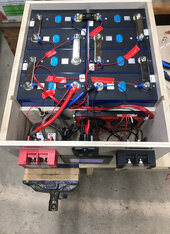MysanthropicBuilders
New Member
Bit of backstory... Going to be moving off grid here in 18 months, I've been researching and studying my butt off but I think I've reached the limit of what I can learn through theory alone when it comes to power. I need to get hands on and start building something. One of the things I'm going to need... Is a solar battery source that I can run things like a table saw off while getting everything built. I also want to pick up welding, and if this could be used for that... Then even better, since my home wiring is nowhere near beefy enough to handle plugging in a welder. I want to keep the total budget under $2,000.
So here's what I know so far: I know I probably want to go with LiFePo4 batteries. They're decently priced and last a long time. Since this might be repurposed later as part of my main home energy storage... May as well get the good batteries. Something around 5 kWh should be good. Batteryhookup has some 3.2v 105Ah cells for ~$40 each, if I can do math then 16 should cover me. These batteries have a continuous discharge rating of 105A, so with 16 batteries that "limits" me to around 5,000 watts for the inverter (Will be plenty for a table saw / drill press / whatever... For welding... Idk). I know I'm going to need a bms for the batteries. I've never used a bms before so... No clue what kind I need. I think I'm going to need a charge controller for the solar panel? Idk, half the stuff I read says this is part of the bms, the other half says I need a separate controller. I know I'm going to need an actual solar panel, or panels, since 5kWh would take a few weeks to charge with a dinky 100w panel or something.
And past that... I'm clueless. I know there should be breakers and fuses somewhere. I don't know where or why. I know there should be bus bars. I don't know where or why. I know I should decide on 12v v.s. 24v v.s. 48v. I don't know which would be best for this application. I know there's a way I can monitor the charge on my phone via bluetooth/wifi. I don't know if that's a premium feature only available through certain manufacturer's, or if there's a way I could do that myself.
The biggest problem I'm having is that when I go to watch a youtube video or read an article or forum post about it... Sometimes it goes into what's being used, rarely does it go into why, and almost never does it go into other alternatives or what they would change if they were to make the system bigger/smaller. So I know I'm going to need more than some batteries, an inverter, some wires, and a BMS... But I don't know what exactly.
If anyone wouldn't mind pointing me in the right direction, that would be greatly appreciated!
So here's what I know so far: I know I probably want to go with LiFePo4 batteries. They're decently priced and last a long time. Since this might be repurposed later as part of my main home energy storage... May as well get the good batteries. Something around 5 kWh should be good. Batteryhookup has some 3.2v 105Ah cells for ~$40 each, if I can do math then 16 should cover me. These batteries have a continuous discharge rating of 105A, so with 16 batteries that "limits" me to around 5,000 watts for the inverter (Will be plenty for a table saw / drill press / whatever... For welding... Idk). I know I'm going to need a bms for the batteries. I've never used a bms before so... No clue what kind I need. I think I'm going to need a charge controller for the solar panel? Idk, half the stuff I read says this is part of the bms, the other half says I need a separate controller. I know I'm going to need an actual solar panel, or panels, since 5kWh would take a few weeks to charge with a dinky 100w panel or something.
And past that... I'm clueless. I know there should be breakers and fuses somewhere. I don't know where or why. I know there should be bus bars. I don't know where or why. I know I should decide on 12v v.s. 24v v.s. 48v. I don't know which would be best for this application. I know there's a way I can monitor the charge on my phone via bluetooth/wifi. I don't know if that's a premium feature only available through certain manufacturer's, or if there's a way I could do that myself.
The biggest problem I'm having is that when I go to watch a youtube video or read an article or forum post about it... Sometimes it goes into what's being used, rarely does it go into why, and almost never does it go into other alternatives or what they would change if they were to make the system bigger/smaller. So I know I'm going to need more than some batteries, an inverter, some wires, and a BMS... But I don't know what exactly.
If anyone wouldn't mind pointing me in the right direction, that would be greatly appreciated!



